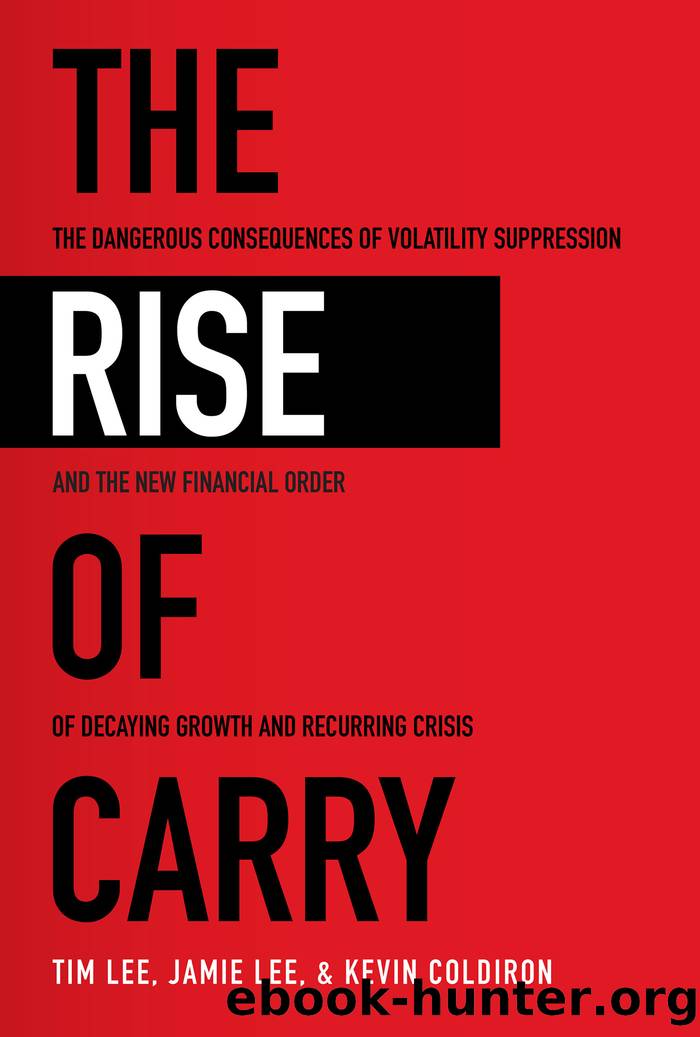The Rise of Carry: The Dangerous Consequences of Volatility Suppression and the New Financial Order of Decaying Growth and Recurring Crisis by Tim Lee;Jamie Lee;Kevin Coldiron;

Author:Tim Lee;Jamie Lee;Kevin Coldiron;
Language: eng
Format: epub
Publisher: McGraw Hill LLC Professional Division
Published: 2020-06-15T00:00:00+00:00
FIGURE 7.1 US household holdings of money as a percentage of total financial assets
Source of data: Federal Reserve Board
How have US households held their assets instead? The answer is in other financial assets, including bonds and debt instruments of various types, equities, and mutual funds including both bond and equity mutual funds (Figure 7.2).
FIGURE 7.2 Percentage of US household assets in equities and mutual funds compared with money
Source of data: Federal Reserve Board
If the financial or economic regime is deflationary, or at least one of low inflation, why would households be so keen to economize on their holdings of money and instead want to put so much into equities and mutual funds? The conventional explanation is that they want some return, and money does not offer much return, particularly today. But the reality is that in a potentially deflationary world the return that money offers (in real terms) is better than it has often been in the past, in far more inflationary times. Equities and mutual funds are risky and over any given period may ultimately not provide any returnâand that should be expected to be particularly likely in a deflationary period.
The true answer is that households are not perceiving equities and mutual funds to be particularly risky. They increasingly have perceived financial assets other than money, including equities, to be the responsibility of the central bank or government, in a similar way to money. If the stock market goes down by a large amount, the Federal Reserve will do whatever is necessary to rescue it. And after all, it can print money. This is what they believe.
The earlier chart (Figure 7.1) showed household holdings of money as a percentage of total household financial assets. Figure 7.3 shows money as a percentage of GDP. Looked at in this way, deposits have recaptured most of the loss that took place during the 1990s. Given the tendency to debt deflation, this is reasonable, but it still falls short of what might have been expected.
Download
This site does not store any files on its server. We only index and link to content provided by other sites. Please contact the content providers to delete copyright contents if any and email us, we'll remove relevant links or contents immediately.
| Corporate Finance | Crowdfunding |
| Financial Engineering | Financial Risk Management |
| Wealth Management |
The Black Swan by Nassim Nicholas Taleb(6801)
Bad Blood by John Carreyrou(6297)
Pioneering Portfolio Management by David F. Swensen(6099)
Millionaire: The Philanderer, Gambler, and Duelist Who Invented Modern Finance by Janet Gleeson(4134)
Skin in the Game by Nassim Nicholas Taleb(4000)
The Money Culture by Michael Lewis(3877)
Bullshit Jobs by David Graeber(3866)
Skin in the Game: Hidden Asymmetries in Daily Life by Nassim Nicholas Taleb(3749)
The Wisdom of Finance by Mihir Desai(3545)
Blockchain Basics by Daniel Drescher(3350)
Liar's Poker by Michael Lewis(3244)
The Intelligent Investor by Benjamin Graham Jason Zweig(2946)
Hands-On Machine Learning for Algorithmic Trading by Stefan Jansen(2932)
Mastering Bitcoin: Programming the Open Blockchain by Andreas M. Antonopoulos(2907)
Fooled by Randomness: The Hidden Role of Chance in Life and in the Markets by Nassim Nicholas Taleb(2886)
Investing For Dummies by Eric Tyson(2810)
The Power of Broke by Daymond John(2795)
Market Wizards by Jack D. Schwager(2561)
Zero Hour by Harry S. Dent Jr. & Andrew Pancholi(2544)
